TRADING TUTORIALS AND PLATFORMS
WHO IS SATOSHI NAKAMOTO
Who is Satoshi Nakamoto?
Why did he or she decide to conceal their name?
Before Bitcoin, there were several attempts of creating digital currencies and the people involved were often getting into a bind with authorities. Many systems were shut down, and there were suspicions of terrorism financing swirling around. All of this might have made the real Satoshi Nakamoto want to hide their name under a pseudonym.
In addition, the creation of Bitcoin opened the way for decentralized economic systems. One of the most significant innovations that Bitcoin brought was the possibility of peer-to-peer transactions with the absence of any intermediary. In line with this philosophy, Nakamoto handed over the Bitcoin source code to other developers and disappeared. Since then, Bitcoin is being developed as an open-source project without a central authority or leader.
Was the creator actually Japanese?
Various linguistic analyzes were performed to examine Satoshi’s writing style. Researchers investigated the Bitcoin's Whitepaper, Satoshi’s forum posts, and also emails. Although they failed to conclusively point any single person, the author was writing in perfect English. Therefore, it is unlikely that Satoshi was actually Japanese.
Was this a single person or a group of people?
Email records indicate that Satoshi was a single person. The programmers who kept in touch with Nakamoto would describe him as a paranoid fellow. He would be nowhere to be found for days, and then he would start sending out dozens of emails on Fridays. Satoshi was worried that somebody might break Bitcoin or something might go wrong with it. All in all, this gives a feeling that Satoshi Nakamoto was a coder, doing Bitcoin on the side, just seeing how this project might move forward.
Are there any theories who Satoshi may be?
There have been many theories relating Satoshi Nakamoto with programming personalities, such as Hal Finney and Nick Szabo. However, each of them clearly refuted any connection to Satoshi.
In 2014, a person named Dorian Prentice Satoshi Nakamoto was uncovered by the media as the real Satoshi. Dorian is a physicist and system engineer living in California, but he claims that he has nothing to do with Bitcoin. In contrast, Craig Steven Wright has been actively claiming that he is the real Satoshi Nakamoto. However, he has failed to present any tangible proof for his words.
What Is Crypto Mining? How Cryptocurrency Mining Works
Although crypto mining has only been around since Bitcoin was first mined in 2009, it’s made quite a splash with miners, investors and cybercriminals alike. Here’s what to know about cryptocurrency mining and how it works…
Crypto mining (or “cryptomining,” if you’d prefer) is a popular topic in online forums. You’ve probably seen videos and read articles about Bitcoin, Dash, Ethereum, and other types of cryptocurrencies. And in those pieces of content, the topic of cryptocurrency mining often comes up. But all of this may leave you wondering, “what is Bitcoin mining?” or “what is crypto mining?”
In a nutshell, cryptocurrency mining is a term that refers to the process of gathering cryptocurrency as a reward for work that you complete. (This is known as Bitcoin mining when talking about mining Bitcoins specifically.) But why do people crypto mine? For some, they’re looking for another source of income. For others, it’s about gaining greater financial freedom without governments or banks butting in. But whatever the reason, cryptocurrencies are a growing area of interest for technophiles, investors, and cybercriminals alike.
So, what is cryptocurrency mining (in a more technical sense) and how does it work? Let’s break it down.
What Is Crypto Mining? Cryptocurrency Mining Explained
The term crypto mining means gaining cryptocurrencies by solving cryptographic equations through the use of computers. This process involves validating data blocks and adding transaction records to a public record (ledger) known as a blockchain.
In a more technical sense, cryptocurrency mining is a transactional process that involves the use of computers and cryptographic processes to solve complex functions and record data to a blockchain. In fact, there are entire networks of devices that are involved in cryptomining and that keep shared records via those blockchains.
It’s important to understand that the cryptocurrency market itself is an alternative to the traditional banking system that we use globally. So, to better understand how crypto mining works, you first need to understand the difference between centralized and decentralized systems.
Traditional Banks Are Centralized Systems
In traditional banking, there’s a central authority that controls, maintains, and updates a centralized record (ledger). That means that every single transaction has to go through the central banking system, where it’s recorded and verified. Plus, it’s a restricted system — only a small number of organizations (banks) are allowed to connect to the centralized banking system directly.
Cryptocurrencies Use Decentralized, Distributed Systems
With cryptocurrencies, there’s no central authority, nor is there a centralized ledger. That’s because cryptocurrencies operate in a decentralized system with a distributed ledger (more on this shortly) known as blockchain. Unlike the traditional banking system, anybody can be directly connected to and participate in the cryptocurrency “system.” You can send and receive payments without going through a central bank. That’s why it’s called decentralized digital currency.
But in addition to being decentralized, cryptocurrency is also a distributed system. This means the record (ledger) of all transactions is publicly available and stored on lots of different computers. This differs from the traditional banks we mentioned earlier, which are centralized systems.
But without a central bank, how are transactions verified before being added to the ledger? Instead of using a central banking system to verify transactions (for example, making sure the sender has enough money to make the payment), cryptocurrency uses cryptographic algorithms to verify transactions.
And that’s where bitcoin miners come in. Performing the cryptographic calculations for each transaction adds up to a lot of computing work. Miners use their computers to perform the cryptographic work required to add new transactions to the ledger. As a thanks, they get a small amount of cryptocurrency themselves.
Understanding the Terms: Centralized, Decentralized, and Distributed
To help you better understand what I’m talking about, let’s consider the following graphic:
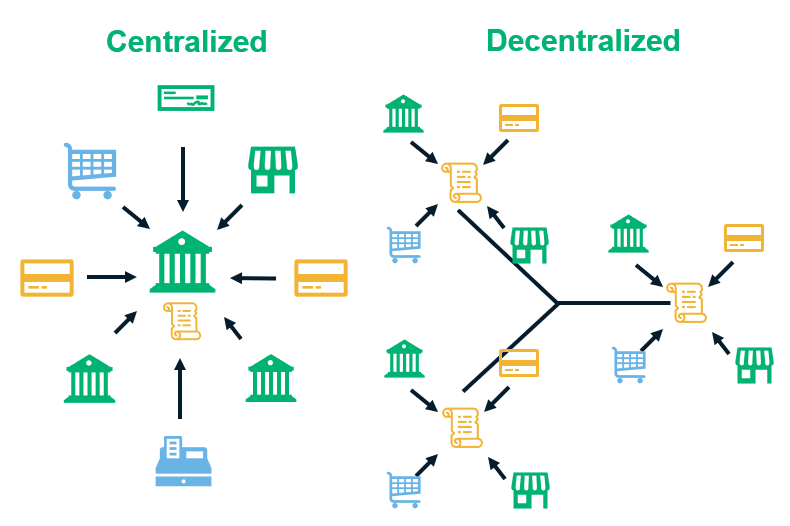
In the left half of the graphic is an illustration of a centralized system. The traditional centralized currency system in the U.S. operates through the use of computers, networks and technologies that are owned, operated and maintained by financial institutions. So, whenever you send money to a family member or a friend, that transaction goes through your bank.
A decentralized system, on the other hand , operates using a network of separately owned, operated and maintained devices. They lend their resources to create this decentralized network and share the responsibility of verifying transactions, updating and maintaining redundant versions of the ledger simultaneously.
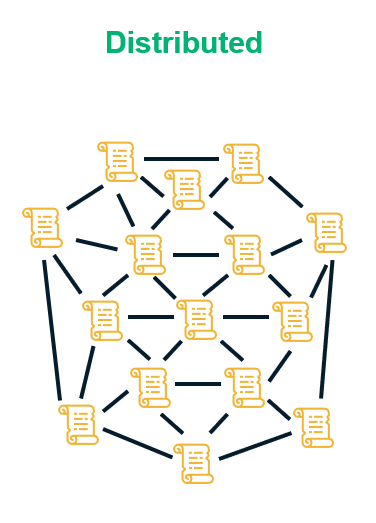
Here, there’s no singular centralized authority that maintains a single ledger (like there would be in a centralized system).
So, when we talk about distribution, what do we mean? Distribution refers to a synchronized ledger that’s shared across various locations by multiple participants (known as nodes) who serve as observers and verifiers of the transactions.
Is Crypto Mining Legal?
In general, the answer is yes. Determining whether crypto mining is legal or illegal primarily depends on two key considerations:
- Your geographic location, and
- Whether you mine crypto through legal means.
However, where you start to tread into the territory of illegal activities is when you use illicit means to mine cryptocurrencies. For example, some cybercriminals use Javascript in browsers or install malware on unsuspecting users’ devices to “hijack” their devices’ processing power. This type of cyber attack is known as cryptojacking. We’re going to publish a separate article on that topic later this month, so stay tuned.
But it’s important to note that cryptocurrency mining is viewed differently by various governments around the globe. The U.S. Library of Congress published a report stating that in Germany, for example, mining Bitcoin is viewed as fulfilling a service that’s at the heart of the Bitcoin cryptocurrency system. The LOC also reports that many local governments in China are cracking down on Bitcoin mining, leading many organizations to stop mining Bitcoin altogether.
Furthermore, some countries view cryptocurrency mining profits as being taxable while other countries view the fruits of such activities as non-taxable income.
We’ll talk more about what makes cryptocurrencies and crypto mining so appealing in a bit. But first, let’s break down how cryptocurrency mining actually works. To do this, we’ll explore the technologies and processes that are involved in it.
How Cryptomining Works (And an In-Depth Look at Blockchain)
In a nutshell, crypto miners verify the legitimacy of transactions in order to reap the rewards of their work in the form of cryptocurrencies. To understand how most cryptocurrency mining works in a more technical sense, you first need to understand the technologies and processes behind it. This includes understanding what blockchain is and how it works.
The first thing to know is that two things are central to the concept of blockchain: public key encryption and math. While I’m definitely a fan of the first, I’ll admit that the latter isn’t my strong suit. However, public key cryptography (aka public key encryption or asymmetric encryption) and math go together in blockchains like burgers and beer.
Traditional cryptocurrencies such as Bitcoin use a decentralized ledger known as blockchain. A blockchain is a series of chained data blocks that contain key pieces of data, including cryptographic hashes. These blocks, which are integral to a blockchain, are groups of data transactions that get added to the end of the ledger. Not only does this add a layer of transparency, but it also serves as an ego inflator when people get to see their transactions being added (chained) to the blockchain. Even though it doesn’t have their names listed on it, it often still evokes a sense of pride and excitement.
Breaking Down the Roles and Processes Within the Bitcoin Blockchain
There are several key components and processes involved in the creation of a blockchain. For this explanation, we’re going to use Bitcoin as our example:
- Nodes. These are the individuals and devices that exist within the blockchain (such as your computer and the computers of other cryptocurrency miners).
- Miners are the specific nodes whose jobs are to verify (“solve”) unconfirmed blocks in the blockchain by verifying the hashes. Once a miner verifies a block, the confirmed block then gets added to the blockchain. The first miner who announces to the rest of the nodes that they’ve solved the hash is rewarded with a cryptocurrency.
- Transactions. A transaction is the thing that gets this party started — I mean, the cryptocurrency mining process rolling. To put it simply, a transaction is an exchange of cryptocurrencies between two parties. Each separate transaction gets bundled with others to form a list that gets added to an unconfirmed block. Each data block must then be verified by the miner nodes.
- Hashes. These one-way cryptographic functions are what make it possible for nodes to verify the legitimacy of cryptocurrency mining transactions. A hash is an integral component of every block in the blockchain. A hash is generated by combining the header data from the previous blockchain block with a nonce.
- Nonces. A nonce is crypto-speak to describe a number that’s used only once. Basically, NIST describes a nonce as “a random or non-repeating value.” In crypto mining, the nonce gets added to the hash in each block of the blockchain and is the number that the miners are solving for.
- Consensus algorithm. This is a protocol within blockchain that helps different notes within a distributed network come to an agreement to verify data. The first type of consensus algorithm is thought to be “proof of work,” or PoW.
- Blocks. These are the individual sections that compromise each overall blockchain. Each block contains a list of completed transactions. Blocks, once confirmed, can’t be modified. Making changes to old blocks means that the modified block’s hash — and those of every block that’s been added to the blockchain since that original block was published — would then have to be recognized by all of the other nodes in the peer-to-peer network. Simply put, it’s virtually impossible to modify old blocks.
- Blockchain. The blockchain itself is a series of blocks that are listed in chronological order. Because previously published blocks can’t be modified or altered after they’ve been added to the blockchain, this provides a level of transparency. After all, everyone can see the transactions.
A Step-by-Step Look at the Crypto Mining Process
Okay, it’s time to take a really granular look at the cryptocurrency mining process and better understand how it works.
1. Nodes Verify Transactions Are Legitimate
Transactions are the basis that a cryptocurrency blockchain is built upon. So, let’s consider the following example to understand how this all comes together:
Let’s say you’re a crypto miner and your friend Andy borrows $5,000 from your other friend Jake to buy a swanky new high-end gaming setup. It’s a top-of-the-line computer that’s decked out with the latest gaming setup accoutrements. (You know, everything from the LED keyboard and gaming mouse to the wide multi-screen display and killer combo headset with mic.) To pay him back, Andy sends him a partial Bitcoin unit. However, for the transaction to complete, it needs to undergo a verification process (more on that shortly).
2. Separate Transactions Are Added to a List of Other Transactions to Form a Block
The next step in the crypto mining process is to bundle all transactions into a list that’s then added to a new, unconfirmed block of data. Continuing with the example of the gaming system transaction, Andy’s Bitcoin payment to Jake would be considered one such transaction.
By adding their transaction to the blockchain (once the verification process is complete), it prevents “double spending” of any cryptocurrencies by keeping a permanent, public record. The record is immutable, meaning it can never be manipulated or altered.
3. A Hash and Other Types of Data Are Added to the Unconfirmed Block
Once enough transactions are added to the block, additional info is added as well, including the header data and hash from the previous block in the chain and a new hash for the new block. What happens here is that the header of the most recent block and a nonce are combined to generate the new hash. This hash gets added to the unconfirmed block and will then need to be verified by a miner node.
In this case, let’s say you’re just lucky enough to be the one to solve it. You send a shout-out to all of the other miners on the network to say that you’ve done it and to have them verify as much.
4. Miners Verify the Block’s Hash to Ensure the Block Is Legitimate.
In this step of the process, other miners in the network check the veracity of the unconfirmed block by checking the hash.
But just how complex is a hash? As an example, let’s imagine you apply a SHA-256 hash to the plain text phrase “I love cryptocurrency mining” using a SHA-256 hash calculator. This means that the phrase would becomes “6a0aa6e5058089f590f9562b3a299326ea54dfad1add8f0a141b731580f558a7.” Now, I don’t know about you, but I’m certainly not going to be able to read or decipher what the heck that long line of ciphertext gibberish says.
5. Once the Block is Confirmed and the Block Gets Published in the Blockchain
On the crypto miner’s side of things, this is the time for celebration because the proof of work (PoW) is now complete. The PoW is the time-consuming process of solving the hash and proving to others that you’ve legitimately done so in a way that they can verify.
From the user’s side of things, it basically means that Andy’s transfer of a partial Bitcoin to Jake is now confirmed and will be added to the blockchain as part of the block. Of course, as the most recently confirmed block, the new block gets inserted at the end of the blockchain. This is because blockchain ledgers are chronological in nature and build upon previously published entries.
How These Components Work Together in the Blockchain Ecosystem
So, how does this ledger stay secure from manipulation and unauthorized modifications? All of the transactions for the ledger are encrypted using public key cryptography. For the blocks to be accepted, they must utilize a hash that the miner nodes on the blockchain can use to verify each block is genuine and unaltered.
Who Updates the Blockchain (and How Frequently)?
Because there’s no centralized regulating authority to manage or control exchanges, it means that the computers that mine that specific type of cryptocurrency are all responsible for keeping the ledger current. And updates to the blockchain are frequent. For example, Buybitcoinworldwide.com estimates that the Bitcoin blockchain gains a new block every 10 minutes through the mining process.
With a cryptocurrency blockchain, anyone can see and update the ledger because it’s public. You do this by using your computer to generate random guesses to try to solve an equation that the blockchain system presents. If successful, your transaction gets added to the next data block for approval. If not, you go fish and keep trying until either you’re eventually successful. Or you decide to spend your time and resources elsewhere.
Now that you understand what cryptocurrency mining is and how it works, let’s take a few moments to understand the attraction of cryptocurrencies and why someone would want to mine them.
A Quick Look at the Different Types of Cryptocurrencies
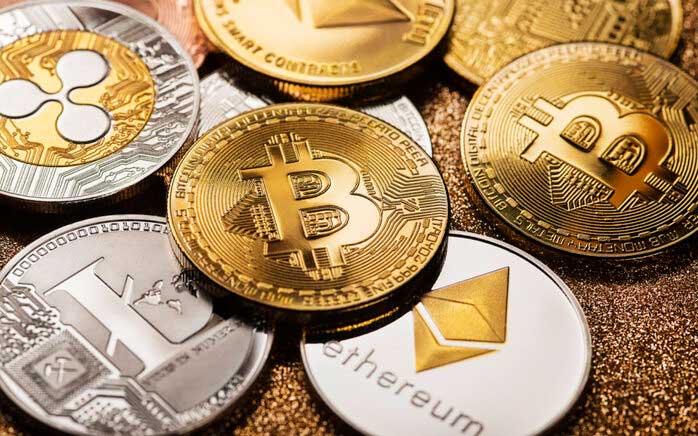
You may be wondering what types of cryptocurrencies are out there. You’ve likely heard of a few, such as Bitcoin (BTC), Dash (DASH), and Monero (XMR). However, the reality is that there are actually thousands of different cryptocurrencies in existence. Coinmarketcap.com reports that there are 7,433 cryptocurrencies as of Oct. 16, 2020, and the global crypto market is worth more than $356 billion.
The current values of cryptocurrencies vary greatly and fluctuate daily. For example, yearn.finance (YFI) is worth $14,134.78 per unit and Bitcoin is worth $11,363.07 per unit. BitTorrent (BTT) and Dogecoin (DOGE) are worth just $0.000339 and $0.002572 per unit.
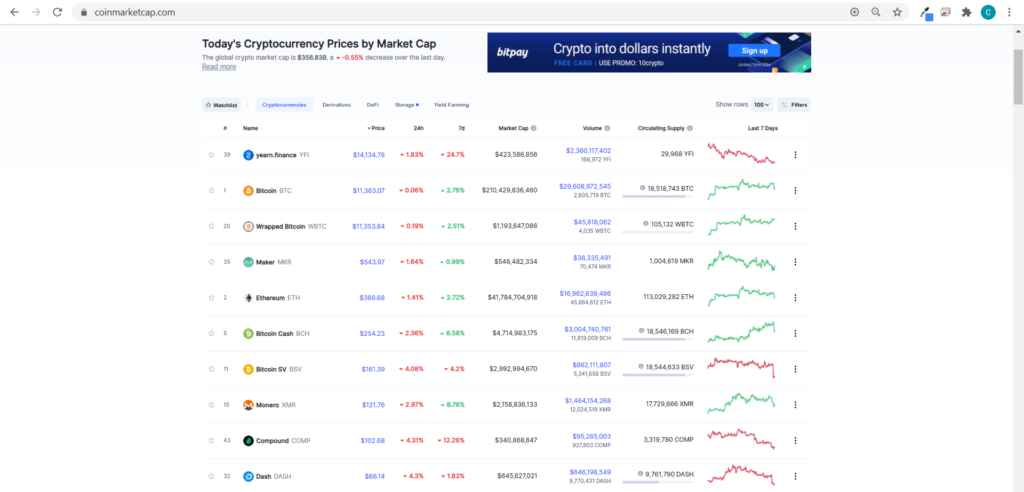
Why Is Crypto Mining Such a Big Deal?
People love being able to use money digitally. Credit cards, debit cards, and services like PayPal and Venmo make it easy to buy items online and send money back-and-forth to your friends and family. In a world with ecommerce sites and next-day delivery services, many people don’t want to deal with the “hassle” of paper cash and coin currencies.
But what leads people to engage in crypto mining? There isn’t a one-size-fits-all response to that question. After all, people have different needs, interests and goals. We’ll explore just a few of them here now…
1. People Seek Greater Privacy and Control of Their Finances
Not everyone is as trusting of the existing systems. And some would prefer to have greater control — and privacy — when it comes to their finances. The idea here is that Uncle Sam doesn’t need to know when you purchase underwear or how much you spent on that new surround-sound audio system.
To avoid being a part of the traditional centralized banking system, some people keep money under their mattresses or rolled up in old coffee cans in their pantries. But there’s another way that people can keep their money out of the traditional centralized banking system: by mining for and using cryptocurrencies.
Cryptocurrencies such as Bitcoin, Dash, Ethereum and Monero offer a certain level of anonymity to users. Why? Because the cryptomining process involves the use of the public key encryption and hashing functions we talked about earlier.
2. It’s All About the Benjamins
Data from Coherent Market Insights indicates that the global cryptocurrency mining market is expected to surpass $38 billion by 2025.
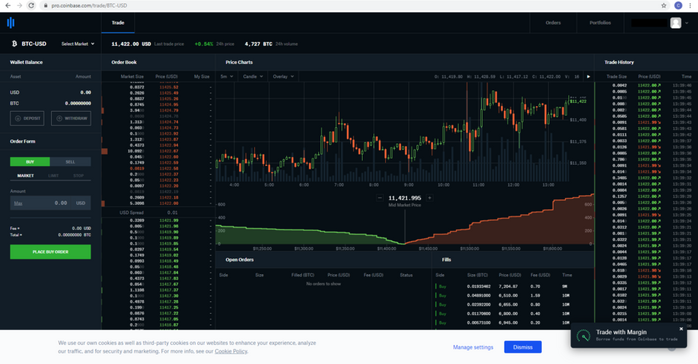
A screenshot of the coinbase.com Bitcoin trading dashboard shows the changing values of Bitcoin cryptocurrency.
And for some, crypto mining can be incredibly profitable and is thought to be a good investment. But for many users, this often isn’t the case because there are a lot of resources that go into mining them and often not a high return.
Some cryptocurrencies, such as Bitcoin, are worth a lot of money when you cash them in. Part of this is because they’re limited in terms of supply, maxing out at a total of 21,000,000, and there are already 18,512,200 BTC that have been mined.
And people have the option of buying and selling fractions of Bitcoins, which are known as Satoshi. There are 100,000,000 Satoshi per BTC.
3. Crypto Is Still New, Exciting and “Shiny”
Let’s face it: There are people out there who want to ride the newest technology waves to be a part of the experience. Essentially, they want to be a part of the next best thing. But how many people are involved in crypto mining? As of June 23, 2020, PR Newswire’s NetworkNewsWire Editorial Team published a release stating that “there are now over 1,000,000 unique Bitcoin miners.”
And to think, that number is just for the people who are mining Bitcoin specifically!
If Cryptocurrency Mining Is So Simple, Why Doesn’t Everyone Do It?
While everyone might want to take advantage of crypto mining, the fact is that it’s not for everyone.
1. Crypto Mining Is Resource-Intensive
For one, cryptocurrency mining nowadays requires a lot of resources both in terms of computing power and electricity. Why? Because crypto mining requires a lot of computing power to generate new guesses continually. If you’re successful, then not only do you generate new Bitcoin, but you also get to update the blockchain by adding information to the end of the ledger.
2. Crypto Mining Is Expensive
Not only do you have to worry about having enough processing power and electricity to power your operation, but you also need to keep in mind the costs associated with such a massive initiative. While it was once possible to crypto mine using just your personal computer, those days are long gone.
If you want to have even a slight chance of beating other cryptocurrency miners to the punch, then you need to have the tech and processing capacity to compete at their level. This means having more devices and access to less expensive power.
3. The ROI Ain’t What It Used to Be
While it’s true that some people have been able to make money by mining cryptocurrencies, the same can’t be said for everyone. And the more that time goes on and the more people that get involved, the decreasing return on investment that crypto miners could expect to receive.
Let’s consider Bitcoin as an example. Approximately every four years (or ever 210,000 blocks mined), Bitcoin experiences an event known as a halving. What this means is that the number of Bitcoins that people would receive as a reward for every blockchain block mined would reduce by half. So, when people first started mining Bitcoins back in 2009, they’d receive 50 BTCs per block. As of the last halving, which took place on May 11, 2020, that rate has since reduced to 6.25 BTC per block.
Here’s a breakdown of how the halving events have reduced the numbers of BTCs you could expect to receive as a miner:
| Year | BTC Received Per Block | Event |
| 2009 | 50 BTC | (Original BTC Mining Rate) |
| 2013 | 25 BTC | First Halving Event |
| 2016 | 12.5 BTC | Second Halving Event |
| 2020 | 6.25 | Third Halving Event |
4. It’s Not Feasible (Or It’s Prohibited) In Your Geographic Location
We mentioned earlier that while cryptocurrency mining isn’t illegal in some areas, in some places it is. As we mentioned earlier, governments globally have different viewpoints of cryptocurrencies in terms of crypto mining. Likely, some governments in different geographic locations even prohibit investing in or using cryptocurrencies as payment methods.
Final Thoughts on Cryptocurrency Mining
Cryptocurrency mining is an interesting alternative to the traditional centralized systems that currently operate throughout the world. However, it’s very taxing in terms of computer and power resources and isn’t feasible for many users as a result.
WHO ACCEPTS CRYPTO AS PAYMENT?
Who Accepts Bitcoin in 2021?
Before you get yourself some bitcoin, you may wonder who accepts bitcoin as payment? Since bitcoin is relatively new and many businesses are wary of its price fluctuations, you may not find it surprising that it is not as widely accepted as...

Before you get yourself some bitcoin, you may wonder who accepts bitcoin as payment? It's been 12 years since its inception, and the number of merchants and service providers who accept bitcoin keeps on growing. From Substack to Microsoft, Tesla to the country of El Salvador, spending BTC is becoming increasingly easier with every passing day.
According to Coinmap.org, there are over 23,000 venues all over the globe where you can purchase goods and services using bitcoin. The actual number of vendors accepting bitcoin is likely much higher, considering how large its ecosystem has gotten. Besides, you can already spend bitcoin via e-pay services like PayPal, BitPay, and others, and you can also spend it like regular money using cryptocurrency debit cards issued by, CEX , Coinbase, Binance, Bitpanda, and many others.

Here is a renewed list on well-know service providers and vendors that would gladly accept your BTC. Keep in mind that it is nearly impossible to cover every company and service accepting bitcoin as means of payment, but hopefully this list will give you a correct impression on how far the ecosystem has come.
Tech Companies That Accept Bitcoin

- Microsoft. The giant from Redmond supports the option of topping up one’s Microsoft account with BTC. Although it was removed for a brief period, in 2021 bitcoin can be used to buy apps or games from Microsoft's Windows or Xbox stores, without support for purchasing stuff from its online store. While the company’s earlier record of supporting bitcoin has been spotty, its support for this cryptocurrency is surely a wind in the sails of crypto promoters.
- AT&T. Proud as the first mobile carrier to accept crypto payments, AT&T allows crypto payments through BitPay.
- Namecheap. This popular domain management and registration site was urged on by the tech community to add bitcoin as a means of payment.
- The Internet Archive. The scholarly archive allows you to donate with bitcoin among other currencies like ethereum, filecoin, XRP and zcash.
- ExpressVPN. With Bitpay, the privacy tool allows you to pay using bitcoin.
- DishNetwork. You can use bitcoin and bitcoin cash to pay for a subscription with the TV connectivity company.
- Grooveshark. Grooveshark, the music streaming service, uses Stripe to process bitcoin payments.
- SEOclerks.com The SEO-focused job marketplace allows you to pay for services with bitcoin.
- Substack. One of the most popular internet newsletter services now lets you pay your favorite creators in bitcoin.
- Wordpress.com. Using Bitpay, this website creation platform allows you to pay with bitcoin
Fintech Companies That Accept Bitcoin

- Paypal.It should be no surprise that the once-groundbreaking payment service allows you to buy, sell and hold cryptocurrencies, the new groundbreaking payment gateways.
- Intuit. Intuit’s Quickbooks allows bitcoin acceptance.
- Mint.com. From 2015 onwards, this personal finance app allows you to track your bitcoin.
- Coinfuel. You can buy discounted Gas Gift Cards with bitcoin.
- ForexTime (FXTM). This trading platform of currencies and other commodities also has cryptocurrency trading.
- AvaTrade. This foreign exchange, CFD and stocks trading platform now has trading options of cryptocurrencies.
- FBS. This platform that focuses on foreign exchange trading now allows you to trade cryptocurrencies.
- eToro. This traditional trading platform of stocks, indices and other commodities has adopted cryptocurrencies.
- Markets.com.
Ecommerce Companies That Accept Bitcoin

- NewEgg. NewEgg is an online retailing powerhouse, particularly when it comes to hardware and electronic gadgets. It was one of the pioneers among the early bitcoin adopters. The platform supports three ways of paying with bitcoin, including web purchases, wallet-based transfers, and transactions made on smartphones. A caveat: bitcoins are not accepted if you want to spend them on digital gift cards, preorders, and subscriptions, so you better make sure to check the fine print in the platform's terms of service. Since then, it is now the first to accept litecoin.
- Online retailer giant Amazon does not accept bitcoin payments. Yet, the options such as Purse.io allow you to buy stuff from its merchants in a more or less direct manner. This platform will link the holders of bitcoin who want to purchase stuff on Amazon with those who want to receive bitcoin in exchange for making an order from the platform.
- Shopify. Shopify is an e-commerce giant which provides the online environment in which the merchants can open their own virtual selling stands, not unlike what you find on eBay. At the moment, tens of thousands of merchants on it are readily accepting bitcoin via the use of BitPay. Unfortunately, the only snag here is the fact that you’ll have to check out and find these stores yourself, as the site does not yet offer the comprehensive list of BTC-friendly sellers. Shopify allows bitcoin payments with Coinbase Commerce, Bitpay, GoCoin and Coinpayments.net. Through these channels, Shopify claims to accept 300+ cryptocurrencies.
- eGifter and Gyft. Gift card platforms such as eGifter and Gyft allow you to spend BTC to buy gift cards that can be used at stores that do not support direct purchases with bitcoins at the moment. Once acquired, these cards can be used with Amazon, Home Depot and other retailers.
- BitPlaza is yet another e-retailer, promising easy support for shopping with bitcoin. The platform’s offer ranges from cosmetics to groceries and electronics. In addition to visiting its online shopping center, you can spend your hard-earned BTC with the help of dedicated Android and iOS apps.
- Etsy. Through the finances and payment settings, you can accept crypto.
- Fancy.com. This global shopping site accepts bitcoin.
Gaming and Entertainment Companies That Accept Bitcoin

- Twitch. Twitch is one of the largest streaming platforms in the world focused on gaming. Popular gamers can carve out an entire career through just streaming games that they like with people attracted to their skill, personality or both. Using NOWpayments, you can pay with bitcoin and litecoin.
- BigFishGames.com. With Coinbase, the casual games creator BigFishGames accepts bitcoin.
- HumbleBundle. This popular site for selling games, ebooks and software also accepts bitcoin, warning users that these transactions are final.
- Xbox. As mentioned in the Microsoft segment above, Xbox allows subscriptions to be paid using bitcoin.
- Zynga. This social gaming platform allows you to pay with bitcoin.
- Movietickets.com. This online movie ticketing site has accepted bitcoin since 2015.
- Lionsgate films. This famed Hollywood studio partnered with GoCoin to accept crypto payments.
- AMC Theaters. One of the largest movie-going franchises in the US and Canada accepts bitcoin.
Food Companies That Accept Bitcoin

- Subway. As early as 2013, the American sandwich shop had locations that accept bitcoin.
- Burger King. Burger King Germany and Venezuela accept bitcoin. Interestingly, Burger King Russia has released a whoppercoin.
- KFC. KFC released a bucket that you can only pay with bitcoin, a crypto meal deal.
- The Pink Cow - Japan. This restaurant became famous for being one of the few places in 2014 to have a bitcoin ATM in Japan. They’re often cited as a pioneer when it comes to restaurant bitcoin payments.
- Pemburry Tavern. Founded by a former computer scientist, Pemburry tavern is famous for being Britain’s first bitcoin-based pub.
- Old Fitzroy. This pub in Sydney made headlines when it began to accept bitcoin.
- Bitcoin Coffee. This Prague cafe has bitcoin as the only method of payment.
- Dominoes in the Netherlands. 16 Dominoes locations are allowing employees to be paid in bitcoin.
- WholeFoods. If you use the Spedn app, you are able to use bitcoin.
- Coupa Cafe. As early as 2013, this Silicon Valley cafe was an early adopter of bitcoin.
- JustEat. One of the most popular online food order sites accepts bitcoin (in some countries) via third-party payment processors like BitPay.
Travel Companies That Accept Bitcoin

- CheapAir. CheapAir leading the charge here. Among other options, the platform supports paying for international flights with bitcoin, allowing you to fly with confidence with your bitcoin wallet safely tucked away in a virtual pocket. In addition to flights, you can use your favorite crypto to pay for hotel accommodation. If you book flights with bitcoin or other cryptocurrencies, you have access to USD 100 coverage if the fares take a dip after paying for them. The company utilizes Coinbase wallets and is one of the pioneers of bitcoin adoption in the air travel industry.
- Travala.com. Travala.com lets users pay for hotels, flights, activities and even luxury experiences with bitcoin. They have partnered with over 600 airlines and 2.2 million hotels via Expedia. At pixel time, they are considered to be the biggest crypto travel retailer in the world.
- More Stamps Global. CheapAir’s competitor is a rising star platform called More Stamps Global which allows you to book flights and hotels with bitcoin, alongside other crypto- and fiat-based payment options. In addition to flights and accommodation, it supports travel transfers and payment for various services and activities associated with travels, such as renting cars.
- Webjet. Webjet is notable for being the first online travel agency in Australia to accept bitcoin in Feb 2015.
- Alternative Airlines. The platform urges you to start your BTC Travel or crypto vacation by buying with bitcoin.
- Peach Aviation. In 2017, Peach became the first Japanese carrier to accept BTC.
- Virgin Galactic. This futuristic space flight venture will accept BTC.
- Expedia. You can book your airline tickets with bitcoin as Expedia is partnered with Coinbase.
Jewelers and Precious Metal Companies That Accept Bitcoin

- REEDS Jewelers. REEDS Jewelers will allow you to spend BTC at their physical stores and online outlets alike, offering a full range of luxury watches and jewelry. It also supports refunds for purchases made with bitcoins. Yet, you should bear in mind that combined purchases made with BTC and other accepted payment methods are not supported at the moment. This recognizable jeweler was one of the first to accept bitcoin.
- Vaultoro. Along with gold, silver, platinum and palladium, this precious metals company has begun to accept bitcoin.
- Menlo Park. This high end jeweler was the first in the world to accept bitcoin back in 2018.
- Luxe Watches. This watch business allows Bitcoin payments for famed luxury brands such as Rolex and Patek Philippe.
- Saving Pearls. This handmade jewelry shop accepts bitcoin as payment.
- American Bullion. This gold investor company has accepted bitcoin payment, the CEO stating that the crypto had “unlimited potential.”
- SchiffGold. One of the most vocal Bitcoin skeptics online, Peter Schiff, still accepts bitcoin as a means of payment, although his company uses BitPay to immediately convert BTC to USD.
Other Services That Accept Bitcoin
- Wikipedia. The famed open encyclopedia accepts donations of bitcoin, bitcoin cash, and ether using BitPay.
- SavetheChildren. This global nonprofit was one of the first to accept cryptocurrency in 2013 and still accepts bitcoin and other cryptos.
- European School of Management and Technology Berlin. One of the first German institutes of higher education to accept bitcoin.
- University of Cumbria. This UK University is the first in the country to accept bitcoin.
- Juliette Interiors. Known as the first to accept bitcoin, this luxury UK-based furniture retailer has allowed BTC payments since 2017.
- Mobler Design. This furniture company began to accept bitcoin in 2014.
- Red Cross. This vital services nonprofit accepts donations in bitcoin through Bitpay.
- UnitedWay. This community of nonprofits allows bitcoin donations through Giving Block.
- BitGive. After establishing a network of nonprofits, BitGive is known as the first bitcoin nonprofit.
- McLaughlin & Stern. This major law firm began accepting bitcoin all the way back in 2014.
- Central Texas Gunworks. This is the first firearms dealer to accept bitcoin in Texas.
- Inguard. This insurance company was the first to accept bitcoin in 2013.
- Managego. Using this platform, you can pay rent with bitcoin.
Crypto Debit Cards

One of the most convenient ways to spend bitcoin is via a bitcoin-powered debit card like Xapo, BitPay, Coinbase, and other service providers.
- Binance Visa Card. The benefit of the Binance card is it having zero fees, so you don’t have to worry about processing or administrative fees. With up to 8% Cashback on services and the security of the biggest crypto exchange in the world, Binance also has a prepaid card that you can use. With the Binance Funding Wallet, you can hold your crypto until you want to spend it with the Binance Card.
- Bitpanda Card. In addition to crypto, the Bitpanda Card allows you to spend metals. As a Visa Card, it is accepted by 54million+ merchants all over the world. With 0.5% to 2% cashback on every transaction, as well as payment and transaction history with the app, Bitpanda offers a debit solution that is as competitive as several other options on the market.
All in all, a retailer who accepts bitcoin is likely to gain a bigger following due to network effects and appeal to a broader target group. Although some people argue that bitcoin is better used as a savings vehicle than means of payment, the growth of Lightning network may usher in a new era of cheap and unstoppable Bitcoin ecommerce.







